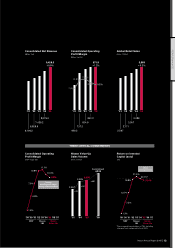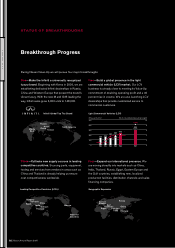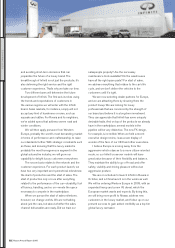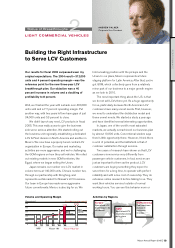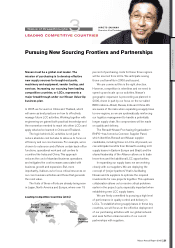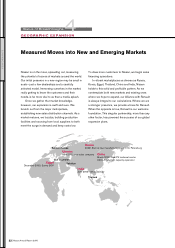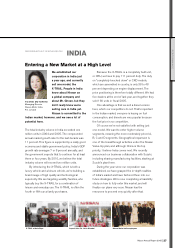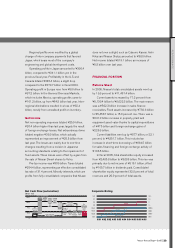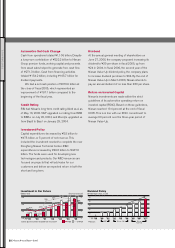Nissan 2006 Annual Report Download - page 23
Download and view the complete annual report
Please find page 23 of the 2006 Nissan annual report below. You can navigate through the pages in the report by either clicking on the pages listed below, or by using the keyword search tool below to find specific information within the annual report.
Nissan Annual Report 2005 21
percent of purchasing costs for these three regions
will be sourced from LCCs. We anticipate seeing
those cost benefits in 2006 and beyond.
We are convinced this is the right direction.
However, competition is relentless and we need to
speed up and scale up our activities. Nissan’s
geographic expansion is proceeding as planned in
2006, driven in part by our focus on the so-called
BRIC nations—Brazil, Russia, India and China. We
are aware of the risks when expanding a supply base
to new regions, so we are systematically reinforcing
our logistics management to handle a potentially
longer supply chain. No compromises will be made
on quality and delivery.
The Renault-Nissan Purchasing Organization—
RNPO—has formed a Common Supplier Panel,
which identifies Renault and Nissan supplier
candidates, including those in LCCs. At present, we
can anticipate benefits from Renault’s existing LCC
supply bases in Eastern Europe and Brazil, and the
shared leadership of the Alliance allows us to trade
know-how and find additional LCC opportunities.
In expanding our supply base, we are working
closely with our suppliers. We are deploying the
concept of “project partners” that is facilitating
Nissan and its suppliers to optimize the required
investments for new projects together. This upstream
collaboration allows us to resolve critical problems
earlier in the project cycle, especially important when
establishing new LCC supply bases.
We are firmly committed to pursuing a high level
of performance in quality control and delivery in
LCCs. To establish strong supply bases in these key
countries, we will focus on the effective deployment
of our purchasing activities with our global network
and seek further enhancements of our current
partnerships with suppliers.
LEADING COMPETITIVE COUNTRIES
Nissan must be a global cost leader. The
mission of purchasing is to develop effective
new supply sources for bought-out parts,
machinery and equipment, vendor tooling, and
services. Increasing our sourcing from leading
competitive countries, or LCCs, represents a
major breakthrough under our Nissan Value-Up
business plan.
In 2005 we focused on China and Thailand, which
will serve as best practices on how to effectively
manage future LCC activities. Working together with
engineering we gained both practical knowledge and
the momentum needed to reach into other LCCs and
apply what we’ve learned in China and Thailand.
The logic behind LCC activities is not just to
reduce absolute cost but also to allow us to focus on
efficiency and our core business. For example, we’ve
chosen to outsource and offshore certain back-office
functions, operational work and call centers to
countries like India and China. This approach
reduces the cost of standard business operations
and mitigates the cost increases associated with
business growth and expansion. But, more
importantly, it allows us to focus critical resources on
our core business activities and those that generate
the most value.
The fruits of these efforts are already being seen
in Japan, North America and Europe, where over 15
Pursuing New Sourcing Frontiers and Partnerships
HIROTO SAIKAWA
Executive Vice President
Status of Breakthroughs 3
PERFORMANCE
China
Russia
Mexico
Mercosur
Countries
India
Eastern
Europe
ASEAN
Maghreb
Leading Competitive Countries (LCCs)




